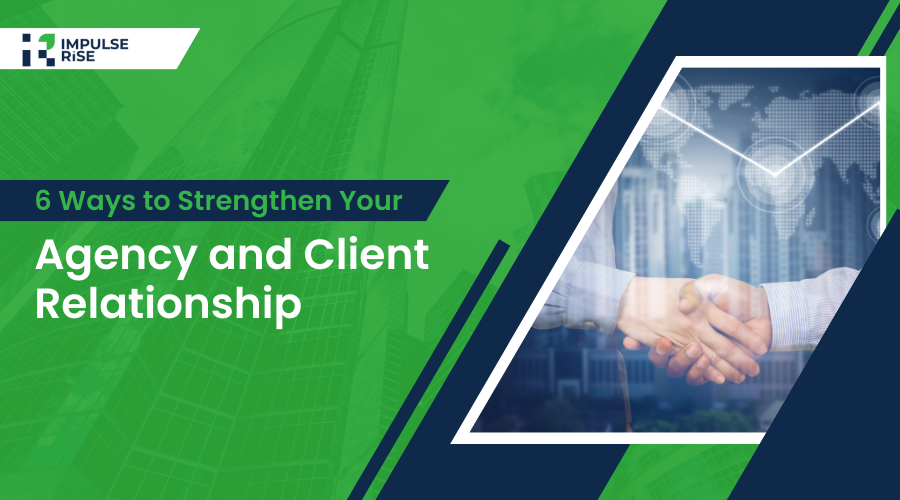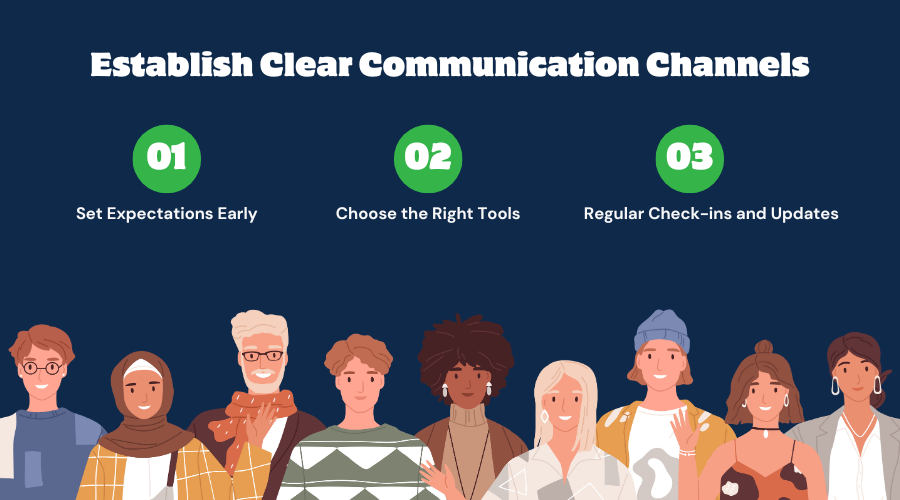
People think that working with an agency is simple: you just hire them, they do their work, and you get results. But in reality, things aren’t that simple because there are many issues that can happen, like sometimes there’s miscommunication, different expectations between employees and employers, or just a lack of understanding on both sides and when such issues take place, everything gets messed up — even if both sides are doing good.
That’s why it is important to have a strong agency and relationship, because it’s not just about signing a contract; there are many more things involved. There should be a good and real connection where both the agency and client understand each other. When this happens, business runs smoothly and results are faster than ever, which keeps everyone happy.
In this blog, we’re gonna discuss the key steps you can take to build a strong agency and client relationship. These aren’t just theoretical tips, they’re real and practical ways that make sure that you’re creating a strong connection that is going to be beneficial for every member of the agency.
So, let’s get started to know about everything that keeps client-agency teams working well.
How to Keep the Agency and Client Relationship Strong
Building a strong agency and client relationship requires a lot of hard work from both sides, as it’s not just about sending tons of emails or checking the tasks that need to be done. It’s about building a consistent work relationship that is based on trust, clear communication, and mutual respect on both ends. Let’s discuss some key points of building a strong agency and client relationship.
1. Establish Clear Communication Channels
Clear and effective communication is the foundation of any business; we all know that, right? If there’s no good communication, there are more chances that misunderstandings take place with lead to stress and delays. If you aren’t talking or you’re communicating in the wrong way, you’ll face problems over time. Therefore, you’ve to make sure to establish good communication from the start.

Set Expectations Early
The first step is to set communication expectations early, which means you’ve to discuss how and when you’ll communicate.
- What tools will be used?
- Are you going to use email, Slack, or Microsoft Teams as a primary method for work updates?
- How often will you communicate?
Make sure to set all such details from the start so you can avoid confusion and frustrations. Whether it’s about setting up weekly updates or after every project, setting these boundaries will help both parties stay aligned in their communication.
Choose the Right Tools
The next step is to choose the right communication tools. Whether you use Slack for daily updates, email for formal discussions, or Zoom for face-to-face meetings, make sure that both client and agency agree upon using the same tools so that things go as planned.
Regular Check-ins and Updates
It’s also very important that there should be regular check-ins so no one feels left out, and communication keeps going in a flow. Setting consistent updates ensures that the agency and client relationship remains transparent and healthy, and this also keeps them away from major problems.
2. Define Roles and Responsibilities
One of the key steps of a successful agency and client relationship is to define clear roles and responsibilities so that everyone has a clear idea of who is responsible for what task. Let’s discuss why defining roles and responsibilities is important to make all the work much smoother for both parties.
Clarity in Duties
Before you start a project, you should outline who is responsible for what takes right from the beginning of the work. For example, if the task is about content creation, designing visuals, managing social media companies, or anything else, you should know who can handle each part of the project so that things work smoothly and remain on track. This thing also ensures that trust and credibility are maintained among both parties.
Avoiding Overlaps
Next, preventing task overlap is crucial in agency and client relationships because when roles aren’t defined, different team members might be working on the same task, which leads to confusion, revisions, delays, or even waste of resources. So, make sure that each party exactly knows what they have to do and until when, so the process stays efficient and there are no or less chances of errors taking place.
Accountability
Accountability is also of core importance in any agency-client partnership because when both of them know about their goals, it’s easier to hold each party accountable for their part of the project. It makes sure that the project is completed before deadline, quality standard is maintained, and the final result aligns with the initial mission. When both the agency and the client understand that they are accountable for what they are doing, it encourages both of them to put their best efforts into achieving the desired outcomes.
3. Align on Goals and Objectives
For any client-agency collaboration, it is important that both parties have aligned goals and objectives, which ensure that both are working for the same outcomes. If neither of them is working for the same goals, it will create problems and also weaken the agency and client relationship.
Shared Vision
The first step is to build a shared vision for the project on which they have to work. Both the agency and the client must agree on the same outcomes they’ve to achieve. If they don’t have a common shared vision, one party might get dissatisfied with the results. Therefore, make sure that the goal is clear so that you both are committed to one plan that drives success.
Setting KPIs
Once you’ve set the project goals, the next important step is to know how success will be measured, and that’s where key performance indicators (KPIs) come into play. KPIs set the guidelines to track the progress and measure the effectiveness of the work being done. If you don’t use KPIs, you can’t determine if the project is going right or if adjustments need to be made.
Regular Reviews
It’s also very important to incorporate regular reviews into the project timeline so that both parties can assess their progress and make necessary adjustments to their work.
4. Celebrate Successes Together
People mostly neglect celebrating success and milestones in agency and client relationship, but honestly, it plays a huge role in making the relationship stronger. When both the client and the agency celebrate small or big achievements of each other, it creates a positive and healthy environment.
Acknowledging Achievements
Acknowledging achievements of each other is one of the simplest yet most effective ways to make the bond stronger and friendlier. When you have reached the project milestone, completed a campaign successfully, or stayed on track throughout the project, you should celebrate such achievements, which keeps the environment happier, and these moments help both the agency and client feel proud of the work they’ve done together.
Team Morale
When someone is appreciated at work, they become more motivated and engaged to do their level best, right? So, when agency and client appreciate each other and celebrate together, it increases their confidence and morale because team members realize that their work is valued, and this motivates put all of their efforts to generate the desired outcomes. It also helps prevent burnout, which, as a result, leads to better overall results and a stronger long-term relationship.
Shared Rewards
Celebrating as a team builds a sense of unity, and both parties feel like they’re working for the same goal. Having a joint lunch, a virtual celebration, or even just an appreciation email makes the other party feel valued.
5. Address Issues Quickly and Professionally

Every business has to face some issues, no matter how well it carries out the agency and client relationship, but how they handle the problems and fix them is what that’s really matters. Knowing problems quickly and solving them professionally also makes the client and agency relationship stronger.
Early Detection
Identifying the problem initially is very important to easily solve it; otherwise, the more time passes, the more complex it becomes. It’s crucial to have regular check-ins and communicate openly so that potential problems can be spotted before they become serious issues. For example, if a client says that the campaign isn’t aligning with their brand, the agency can make necessary adjustments during the early stages, which ensures that the final results meet the expectations.
Professional Solution
Once an issue is identified, it’s essential to resolve it with professionalism and empathy. Both sides should approach the situation with a collaborative mindset, aiming to solve the problem rather than assign blame. Whether the issue is related to a budget, a deliverable, or timeline, it’s important for both the agency and client to stay calm and respectful.
Learning from Challenges
Lastly, handling issues should always come with a mindset of learning from challenges. Instead of viewing problems as setbacks, both the agency and client should see them as opportunities for growth. After resolving an issue, it’s beneficial for both parties to reflect on what caused it and what can be done differently next time to prevent similar challenges. Whether it’s refining the communication process, adjusting timelines, or aligning expectations earlier, learning from mistakes helps improve the process for future projects and strengthens the overall relationship.
6. Invest in Relationship Building
A strong agency and client relationship isn’t just about completing a project successfully, it’s about building a connection that goes long-term and grows over time. If you invest your time and efforts to build your relationship, you’ll continue to value each other even after the end of the project.
Regular Check-Ins
Regular check-ins are an important way to know each other better, even if there’s nothing to be discussed, both the client and the agency should have a casual conversation about how things are going, or you can even discuss your personal interests to make your connection stronger. Such informal conversations help create a strong and genuine bond that goes beyond business.
Understanding Each Other
Understanding each other’s working styles and preferences can prevent misunderstandings down the road. Every client and agency has different workflows, communication styles, and expectations. By taking the time to learn how the other party prefers to operate, you can streamline communication and collaboration. For example, some clients may prefer detailed reports while others might opt for more frequent, short updates. Agencies might work best with clear, upfront deadlines, while clients may want more flexibility. Recognizing these differences and adjusting accordingly helps build a smoother, more efficient working relationship.
Long-Term Perspective
Finally, it’s important to approach the relationship with a long-term perspective. While completing a project is important, it shouldn’t be the only focus. Both the agency and client should make efforts to create a relationship that extends beyond the current project. By maintaining communication and checking in periodically even after the project is completed, both parties can position themselves for future collaborations. Long-term relationships are built on trust and mutual respect, and investing in that relationship early on helps create a foundation for future success.
Conclusion
In the world of business, a successful agency and client relationship can make all the difference. From establishing clear communication to celebrating successes together, each step plays a crucial role in building a long-lasting, productive partnership. It’s not just about completing projects—it’s about creating a bond built on trust, mutual respect, and a shared vision for the future.
By defining roles and responsibilities, aligning on goals, and addressing issues professionally, agencies and clients can navigate challenges more effectively, ensuring smoother project execution and better results. Investing time in regular check-ins, understanding each other’s working styles, and maintaining a long-term perspective will help both sides feel valued and appreciated, leading to stronger and more rewarding collaborations.
At the end of the day, fostering a healthy agency and client relationship is about recognizing that both parties are working toward the same goal. When communication flows freely, trust is built, and success is celebrated, everyone benefits. Keep these strategies in mind, and you’ll be on your way to creating a partnership that lasts for years to come.

